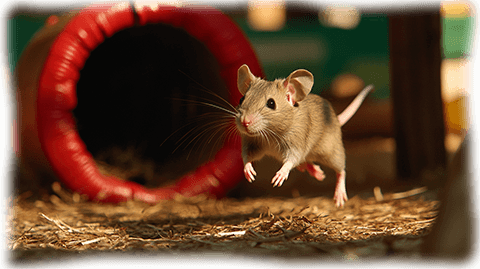Training Mice and Rats: A Comprehensive Guide
Contrary to what many might think, mice and rats are highly intelligent and can be trained to perform various tasks and respond to commands. These small pets thrive on mental stimulation and training is a fantastic way to enrich their lives and build a strong bond with them. Here’s a detailed guide to training your pet mice or rats, along with practical tips and resources to help you along the way.
Why Train Your Mouse or Rat?

Training small rodents like mice and rats serves multiple purposes beyond just being fun. It strengthens the bond between you and your pet, helps to keep them mentally and physically stimulated, and can even help with practical purposes like potty training or preventing undesirable behaviors.
Rats, in particular, are highly intelligent animals, capable of learning complex tricks and commands, while mice, although smaller and more independent, are quick learners for basic tricks and tasks.
General Tips for Training Mice and Rats
Before diving into specific tricks, it’s essential to keep a few general training principles in mind:
- Positive Reinforcement – Always use rewards like treats, praise, or gentle petting when your pet performs the desired action. Avoid punishment, as this can create fear. (Amazon affiliate link)
- Consistency – Make sure you use the same commands and signals consistently to avoid confusing your pet.
- Short Sessions – Keep training sessions brief (5-10 minutes) to maintain your pet’s attention and avoid boredom.
- Be Patient – Mice and rats are fast learners, but they still require patience and repetition. Some tricks may take time to master.

Best Training Tools
- Clickers – While not essential, clickers are a great tool for marking the exact moment your pet performs the desired behavior.
- High-Value Treats – Use small, easy-to-eat treats as rewards. For rats, try small pieces of fruit or seeds; for mice, sunflower seeds or small pieces of nut work well.
Training Mice
Mice can learn basic tasks and tricks with consistency and positive reinforcement. While their attention span is shorter than that of rats, they can still be trained to recognize certain cues.

Hand Taming
The first step to training your mouse is hand-taming, which helps establish trust and reduces stress during training. Start by offering treats from your hand and gradually encourage your mouse to sit on your palm.
- Patience is key – Approach slowly and allow the mouse to come to you at its own pace.
- Start with gentle touch – Once they’re comfortable, you can begin touching them gently and encouraging them to climb onto your hand for treats.
Potty Training
Believe it or not, you can train a mouse to use a specific area of its cage for bathroom needs. This helps keep the cage clean and makes maintenance easier.
- Set up a designated spot – Place a small litter box in one corner of the cage and move droppings to that spot.
- Reward positive behavior – When your mouse uses the litter area, immediately reward it with a treat.

Teaching Simple Commands
While mice might not perform elaborate tricks, they can be trained to respond to their name, come when called, and follow basic commands like “stand” or “spin.”
- Name Recognition – Use treats to encourage your mouse to come to you when you call its name. Repetition and rewards are essential here.
- Basic Tricks – You can train your mouse to “stand” or “spin” by guiding them with a treat and rewarding them when they follow the command.
Training Rats
Rats are exceptionally intelligent, sociable, and quick to learn. They can be trained to perform a wide variety of tricks, from responding to their name to running agility courses.
Hand Taming and Bonding
Much like mice, the first step to training your rat is hand taming. However, rats are often quicker to bond with humans and can start interacting within a short time.
- Gentle handling – Hold your rat gently and speak to them softly during handling.
- Playtime – Interactive play builds trust and can be part of training. Use toys or even engage in gentle tug-of-war games with soft ropes or cloth.
Teaching Basic Commands
Rats can learn basic commands such as “come,” “sit,” or “fetch.” Training starts with teaching them to respond to their name and come when called.
- Come When Called – Call your rat’s name while offering a treat and reward them as soon as they approach.
- Sit or Stay – Use a clicker or verbal cues to encourage them to sit in place, rewarding them immediately when they comply.
Trick Training
Once your rat has mastered basic commands, you can move on to more complex tricks such as:
- Fetch – You can train your rat to fetch a small ball or toy by rewarding them each time they pick up the object and bring it back to you.
- Agility Courses – Set up small obstacles like tunnels, ramps, or hoops, and train your rat to run through them. Use treats to guide them through the course, and reward them at the end.
Potty Training
Just like mice, rats can also be potty trained. Place a litter box in the corner of their cage and reward them when they use it consistently. (Amazon affiliate link)
Addressing Common Challenges
Training small pets like mice and rats can come with its own challenges, but with patience and understanding, most issues can be overcome.
- Fear or Anxiety – If your pet seems nervous, slow down the training process. Take more time to build trust before moving on to more advanced tasks.
- Short Attention Spans – Keep sessions short and positive, especially with mice, as they have shorter attention spans than rats.
Helpful Resources
- Books – “The Complete Guide to Rat Training” (Amazon affiliate link) by Debbie Ducommun and “Training Your Pet Mouse” by Sheila Webster.
- Online Forums – Join online communities like “The Rat Fan Club” or “Mouse Owners” for tips, support, and advice from other small pet owners.
- YouTube – There are many videos demonstrating training techniques for small pets. Visual aids can help you see training in action.
Final Thoughts
Training your mice or rats can be a fun and rewarding experience. With patience, consistency, and positive reinforcement, you’ll be amazed at what these little animals can learn. Remember, each pet is unique, and the most important thing is to keep the experience enjoyable for both you and your furry friend.
Affiliate Disclosure
This post may contain affiliate links, which means I earn from purchases made through links. Please see the privacy policy page for more details.





